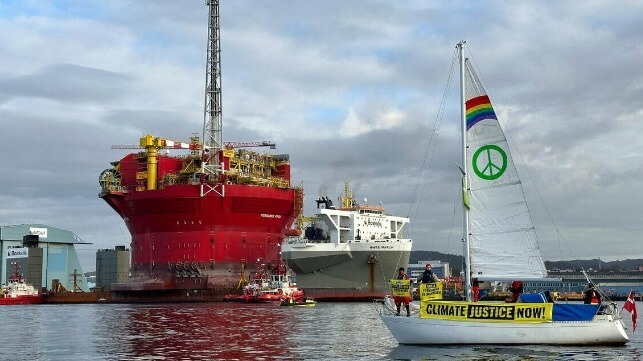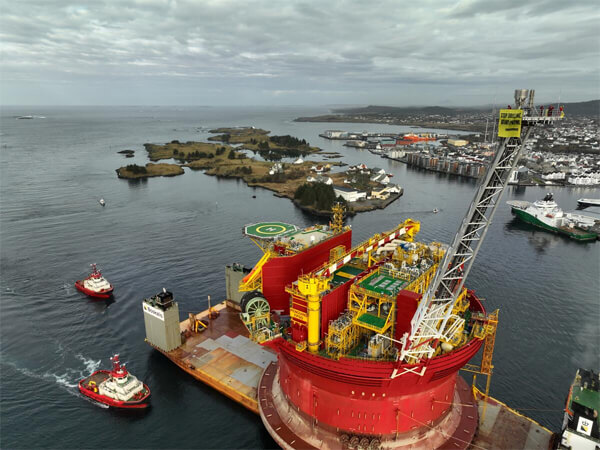Greenpeace Ends its Longest Occupation of a Moving Oil Platform

Thirteen days after boarding a heavy-lift vessel and occupying Shell’s FPSO which was being transported to the North Sea, Greenpeace’s activists left the vessel when it reached Norway. The group’s UK organization said the protest has been Greenpeace’s longest-ever occupation of a moving oil platform.
Protestors took one more opportunity to call attention to their message as the heavy-lift vessel White Marlin made its way into the southern Norwegian port of Haugesund on Sunday morning, February 12. The six protestors aboard the oil platform climbed the 410-foot flare boom on the FPSO to unfurl their banner reading “Stop drilling. Start paying.”
The arrival of the heavy-lift vessel was also met by more Greenpeace protestors circling the vessel with the oil platform aboard Greenpeace Nordic’s 26-foot sailboat Tanker Tracker. They were also displaying protest banners.

Greenpeace's protestors climbed to the top of the platform during the arrival in Norway (© Greenpeace / Matthew Kemp)
A judge in the UK issued an order last week for the protestors to disembark as soon as the vessel docked in Norway. The first four individuals had boarded the White Marlin on January 31 when it was off the coast of Africa and according to Greenpeace traveled approximately 2,150 nautical miles occupying the Shell FPSO. On February 6, two more Greenpeace protestors also boarded the vessel while it was in the English Channel.
The protestors have been calling on Shell to “take responsibility for its role in causing the climate crisis, and to pay into loss and damage funds, to help countries recover from extreme weather caused by climate change,” according to Greenpeace’s statements.
Speaking on behalf of the group, Greenpeace Southeast Asia executive director, Yeb Saño said, “Shell might think this is the end of our protest, but my message to chief executive Wael Sawan is that this is just the beginning.” In addition to occupying the vessel, the group had also staged protests at Shell’s headquarters in London and in the Philippines.
Greenpeace targeted the FPSO as it is Shell’s first new manned vessel deploying in the North Sea in 30 years. It is scheduled to deploy into the Penguins oil field with the project at peak production expected to yield the equivalent of 45,000 barrels of oil per day. Greenpeace is also angered that Shell has said it could open up further areas for exploration in the field.
Shell went to court in the UK three times, first seeking to create an exclusion zone around the heavy-lift vessel as it was traveling north and the court ordered the protestors to agree on a plan to disembark. After the two additional protestors also boarded the vessel the court issued a second injunction to prevent any further protestors from coming aboard the White Marlin and telling those aboard that they had to disembark as soon as the vessel reached Norway.
Greenpeace is now reporting that Shell has also filed a claim in the British courts valued at $120,000 over alleged damages and costs from the protest. Shell is asking the court to order Greenpeace to pay for the increased security required because of the protestors boarding the ship as well as due to the unlawful erecting of solar panels and a wind turbine while they were occupying the platform to power their efforts including communications illustrating the protest.
